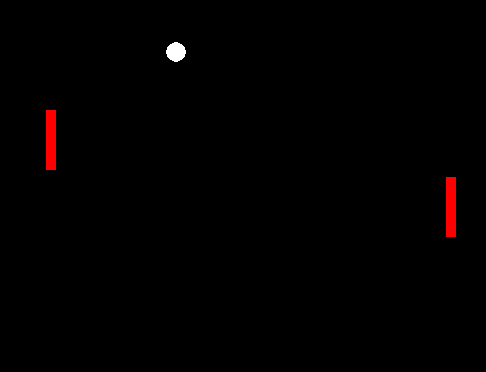import pygame, random, time
# main function where we call all other functions, start the game loop, quit pygame and clean up the window. Inside we create a game object, display surface, and start the game loop by calling the play method on the game object. There is also a set caption with the title of the game.
def main():
pygame.init()
size =(500,400)
surface=pygame.display.set_mode(size)
pygame.display.set_caption('Pong v2')
game = Game(surface)
game.play()
pygame.quit()
# This is where we define the class game
class Game():
# an object in this class represents a complete game
# here we initialize a game. self is the game that is initialized surface is the display window surface object we also set default values for continuing the game and closing the window. we also define what fps we are running the game at, and define the velocity color position and radius of the ball
def __init__(self,surface):
# defining surface, fps, background color
self.surface=surface
self.FPS=120
self.bg_color=pygame.Color('black')
screen_width = surface.get_width()
screen_height = surface.get_height()
# defining ball attributes
ball_radius=10
ball_pos = [random.randint(ball_radius, screen_width-ball_radius),
random.randint(ball_radius, screen_height-ball_radius)]
ball_color=pygame.Color('white')
ball_velocity=[2,1]
self.ball=Ball(ball_pos,ball_radius,ball_color,ball_velocity,surface)
# defining paddle attributes
rect_left=[50,450]
rect_top=225
rect_height=60
rect_width=10
self.Paddle1=Rect(rect_left[0],rect_top,rect_width,rect_height,surface)
self.Paddle2=Rect(rect_left[1],rect_top,rect_width,rect_height,surface)
self.game_Clock=pygame.time.Clock()
self.close_clicked=False
self.continue_game=True
self.score1=0
self.score2=0
self.frame_counter=0
def play(self):
# game is played until player clicks close
while not self.close_clicked:
self.handle_events()
self.draw()
# if nothing sets this to false the game will continue to update
if self.continue_game:
self.update()
self.game_Clock.tick(self.FPS)
# score is drawn onto the screen (unimportant this is just playing with a feature for the next version), we define color font background etc of the score message and update score upon points being scored
def draw_score(self):
font_color = pygame.Color("white")
font_bg = pygame.Color("black")
font = pygame.font.SysFont("arial", 18)
text_img = font.render("Score for Player 1: " + str(self.score1) + ' Score for Player 2: ' + str(self.score2), True, font_color, font_bg)
text_pos = (0,0)
self.surface.blit(text_img, text_pos)
# ball, surface, score, and two paddles are drawn, pygame also updates this drawing once per frame
def draw(self):
self.surface.fill(self.bg_color)
self.draw_score()
#pygame.draw.rect(self.surface,pygame.Color('blue'),(50,225,10,50))
#pygame.draw.rect(self.surface,pygame.Color('red'),(450,225,10,50))
self.Paddle1.draw()
self.Paddle2.draw()
self.ball.draw()
pygame.display.update()
# score value set to default of 0 we tell ball to move and add 1 to frame counter upon each update. update game object for the next frame
def update(self):
self.ball.move()
self.score=0
self.frame_counter+=self.frame_counter+1
# here we setup an event loop and figure out if the action to end the game has been done
def handle_events(self):
events=pygame.event.get()
for event in events:
if event.type== pygame.QUIT:
self.close_clicked=True
# user defined class ball
class Ball:
# self is the ball to intialize. color/center/radius are defined for the ball that is initialized
def __init__(self,center,radius,color,velocity,surface):
self.center=center
self.radius=radius
self.color=color
self.velocity=velocity
self.surface=surface
# screen size is determined and edge of ball is checked that it is not touching the edge. if it is touching the edge it bounces and reverses velocity
def move(self):
screen_width=self.surface.get_width()
screen_height=self.surface.get_height()
screen_size=(screen_width,screen_height)
for i in range(0,len(self.center)):
self.center[i]+=self.velocity[i]
if (self.center[i]<=0 + self.radius or self.center[i]>=screen_size[i] - self.radius):
self.velocity[i]=-self.velocity[i]
# ball is drawn
def draw(self):
pygame.draw.circle(self.surface,self.color,self.center,self.radius)
class Rect:
def __init__(self,left,top,width,height,surface):
#self.left=left
#self.top=top
#self.width=width
#self.height=height
self.surface=surface
self.rect=pygame.Rect(left,top,width,height)
def draw(self):
pygame.draw.rect(self.surface,pygame.Color('red'),self.rect)
def collide(self):
if pygame.Rect.collide(x,y) == True:
return True
else:
return False
main()
Above is my work so far basically its supposed to be the retro arcade game pong where the ball bounces off of the edges of the paddles and if it doesn't the opposite side scores a point upon it hitting the edge of the window. So specifically this part of the project requires me to make the ball bounce off of the front of the paddles and I'm confused as to how to do this. My idea originally was to use the collidepoint method inside of the class Rect that if it returns true would reverse the balls velocity. However, I don't have access to the centre coordinates of the ball inside of the class or inside of the method play in the class game where I intended to make this work on the specific instances of ball and paddle1,paddle2 so I don't know how to do this.

Game.ball.center.